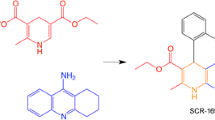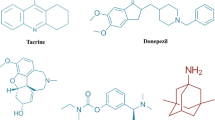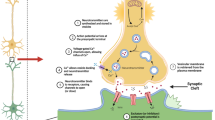Abstract
Rivastigmine is a potent acetyl- and butyrylcholinesterase inhibitor widely used for cognitive improvement in Alzheimer’s disease (AD) therapy. However, dose-limiting adverse effects restrict its tolerability and clinical outcomes. This study explored new combined therapy, in which peripheral cholinergic adverse effects and central cognitive amelioration of rivastigmine were differentiated by a peripheral cholinoceptor antagonist anisodamine. The results demonstrated that rivastigmine (0.75 and 2.0 mg/kg) could significantly reverse the scopolamine-induced cognitive deficit in mice through passive avoidance test. Nevertheless, a high dose of rivastigmine (3.25 mg/kg) would compromise cognitive amelioration and produce obvious adverse effects, including hypersalivation, intestinal hyperperistalsis and muscle cramp. Interestingly, concomitant administration of anisodamine (10 mg/kg) effectively counteracted both the muscarinergic and nicotinergic adverse effects, while facilitating cognitive amelioration of rivastigmine (3.25 mg/kg). These findings provide an insight into the feasibility of combined therapy with cholinesterase inhibitors and peripheral cholinoceptor antagonists for the treatment of AD.




Similar content being viewed by others
References
Birks J, Grimley Evans J, Iakovidou V, Tsolaki M, Holt FE (2009) Rivastigmine for Alzheimer's disease. Cochrane Database Syst Rev, CD001191
Dodart JC, May P (2005) Overview on rodent models of Alzheimer’s disease. Curr Protoc Neurosci 9:9.22.1–9.22.16
Felder CC, Bymaster FP, Ward J, DeLapp N (2000) Therapeutic opportunities for muscarinic receptors in the central nervous system. J Med Chem 43:4333–4353
Forette F, Anand R, Gharabawi G (1999) A phase II study in patients with Alzheimer’s disease to assess the preliminary efficacy and maximum tolerated dose of rivastigmine (Exelon). Eur J Neurol 6:423–429
Frankfort SV, Appels BA, de Boer A, Tulner LR, van Campen JP, Koks CH, Beijnen JH (2005) Discontinuation of rivastigmine in routine clinical practice. Int J Geriatr Psychiatry 20:1167–1171
Gauthier S, Juby A, Morelli L, Rehel B, Schecter R et al (2006) A large, naturalistic, community-based study of rivastigmine in mild-to-moderate AD: the EXTEND Study. Curr Med Res Opin 22:2251–2265
Gottwald MD, Rozanski RI (1999) Rivastigmine, a brain-region selective acetylcholinesterase inhibitor for treating Alzheimer's disease: review and current status. Expert Opin Investig Drugs 8:1673–1682
Holzgrabe U, Kapková P, Alptüzün V, Scheiber J, Kugelmann E (2007) Targeting acetylcholinesterase to treat neurodegeneration. Expert Opin Ther Targets 11:161–179
Inglis F (2002) The tolerability and safety of cholinesterase inhibitors in the treatment of dementia. Int J Clin Pract 127:45–63
Jackisch R, Förster S, Kammerer M, Rothmaier AK, Ehret A, Zentner J, Feuerstein TJ (2009) Inhibitory potency of choline esterase inhibitors on acetylcholine release and choline esterase activity in fresh specimens of human and rat neocortex. J Alzheimers Dis 16:635–647
Jarvie EM, Cellek S, Sanger GJ (2008) Potentiation by cholinesterase inhibitors of cholinergic activity in rat isolated stomach and colon. Pharmacol Res 58:297–301
Lane RM, Potkin SG, Enz A (2006) Targeting acetylcholinesterase and butyrylcholinesterase in dementia. Int J Neuropsychopharmacol 9:101–124
Liston DR, Nielsen JA, Villalobos A, Chapin D, Jones SB, Hubbard ST, Shalaby IA, Ramirez A, Nason D, White WF (2004) Pharmacology of selective acetylcholinesterase inhibitors: implications for use in Alzheimer’s disease. Eur J Pharmacol 486:9–17
Pavlis CJ, Kutscher EC, Carnahan RM, Kennedy WK, Van Gerpen S, Schlenker E (2007) Rivastigmine-induced dystonia. Am J Health Syst Pharm 64:2468–2470
Poupko JM, Baskin SI, Moore E (2007) The pharmacological properties of anisodamine. J Appl Toxicol 27:116–121
Scarzella L, Costanza A, Vastola K (2007) Domperidone is effective in the prevention of rivastigmine-related gastrointestinal disturbances. Funct Neurol 22:101–104
Schmitt B, Bernhardt T, Moeller HJ, Heuser I, Frölich L (2004) Combination therapy in Alzheimer’s disease: a review of current evidence. CNS Drugs 18:827–844
Siddiqui MA, Wagstaff AJ (2006) Rivastigmine: in Parkinson’s disease dementia. CNS Drugs 20:739–747
Stahl SM (2000) The new cholinesterase inhibitors for Alzheimer’s disease, Part 1: their similarities are different. J Clin Psychiatry 61:710–711
Wang H, Lu Y, Chen HZ (2003) Differentiating effects of anisodamine on cognitive amelioration and peripheral muscarinic adverse effects induced by pilocarpine in mice. Neurosci Lett 344:173–176
Wang BS, Wang H, Wei ZH, Song YY, Zhang L, Chen HZ (2009) Efficacy and safety of natural acetylcholinesterase inhibitor huperzine A in the treatment of Alzheimer’s disease: an updated meta-analysis. J Neural Transm 116:457–465
Yang LM, Xie YF, Chen HZ, Lu Y (2007) Diastereomeric and enantiomeric high-performance liquid chromatographic separation of synthetic anisodamine. J Pharm Biomed Anal 43:905–909
Zhang S, Liu J, He L (1995) Anisodamine (654–2) improves impaired cognitive function induced by experimental brain damage. Zhongguo Yi Xue Ke Xue Yuan Xue Bao 17:254–258
Zhang WW, Song MK, Cui YY, Wang H, Zhu L, Niu YY, Yang LM, Lu Y, Chen HZ (2008) Differential neuropsychopharmacological influences of naturally occurring tropane alkaloids anisodamine versus scopolamine. Neurosci Lett 443:241–245
Zhao CL, Ron S, Liu CG, He XP, Xie ZP (1993) Blocking effect of anisodamine on acetylcholine receptor channels. Zhongguo Yao Li Xue Bao 14:190–192
Acknowledgments
This study was sponsored by the National Natural Science Foundation of China (No. 30772553 and 30701018), the Major Basic Research Project of Shanghai Municipal Science and Technology Commission (07DJ14005) and Research Fund for the Doctoral Program of China Education Ministry (200802480058). We thank Ting Zhang, Yan Qin, Jing-Xia Chen, Yi-Qing Shi and Yan Zhou for their contribution to the experiment on muscle cramp evaluation.
Author information
Authors and Affiliations
Corresponding author
Additional information
W.-W. Zhang and Z.-P. Xu contributed equally to this work.
Rights and permissions
About this article
Cite this article
Zhang, WW., Xu, ZP., Cui, YY. et al. Peripheral cholinoceptor antagonist anisodamine counteracts cholinergic adverse effects and facilitates cognitive amelioration of rivastigmine. J Neural Transm 116, 1643–1649 (2009). https://doi.org/10.1007/s00702-009-0297-7
Received:
Accepted:
Published:
Issue Date:
DOI: https://doi.org/10.1007/s00702-009-0297-7




